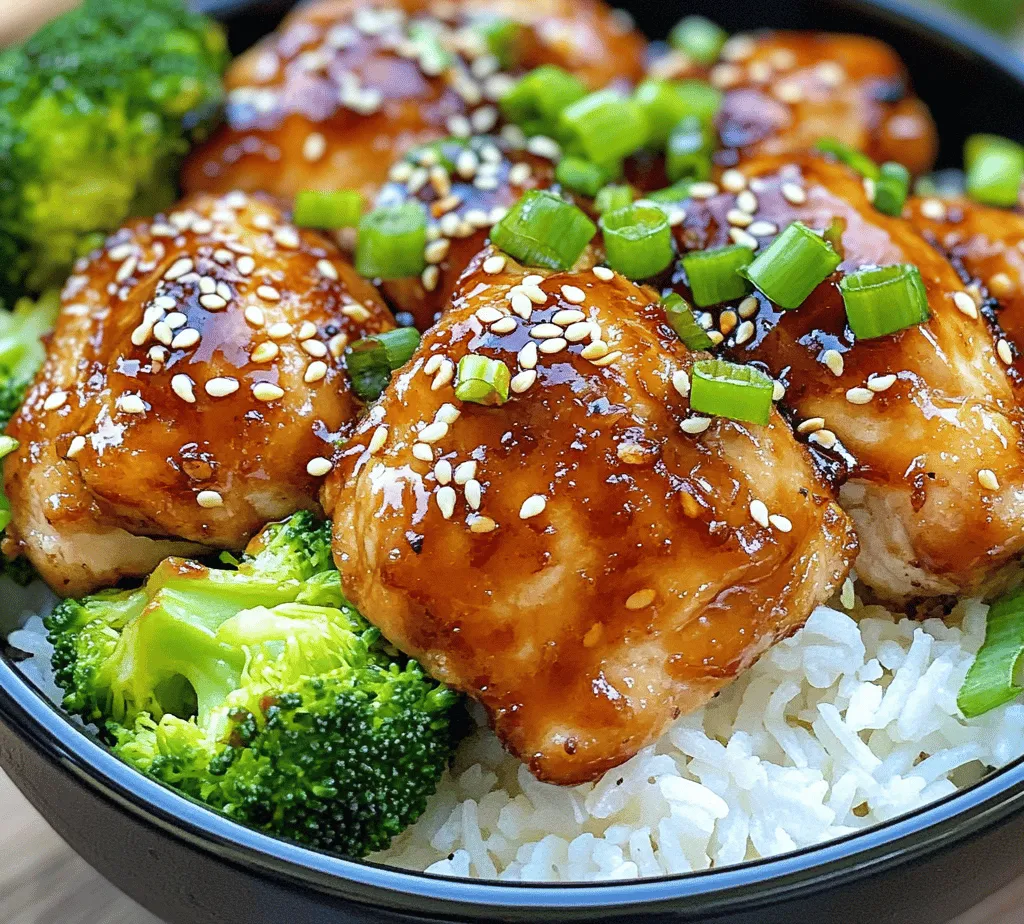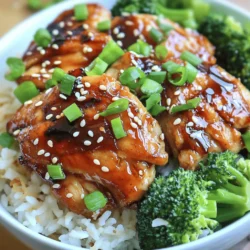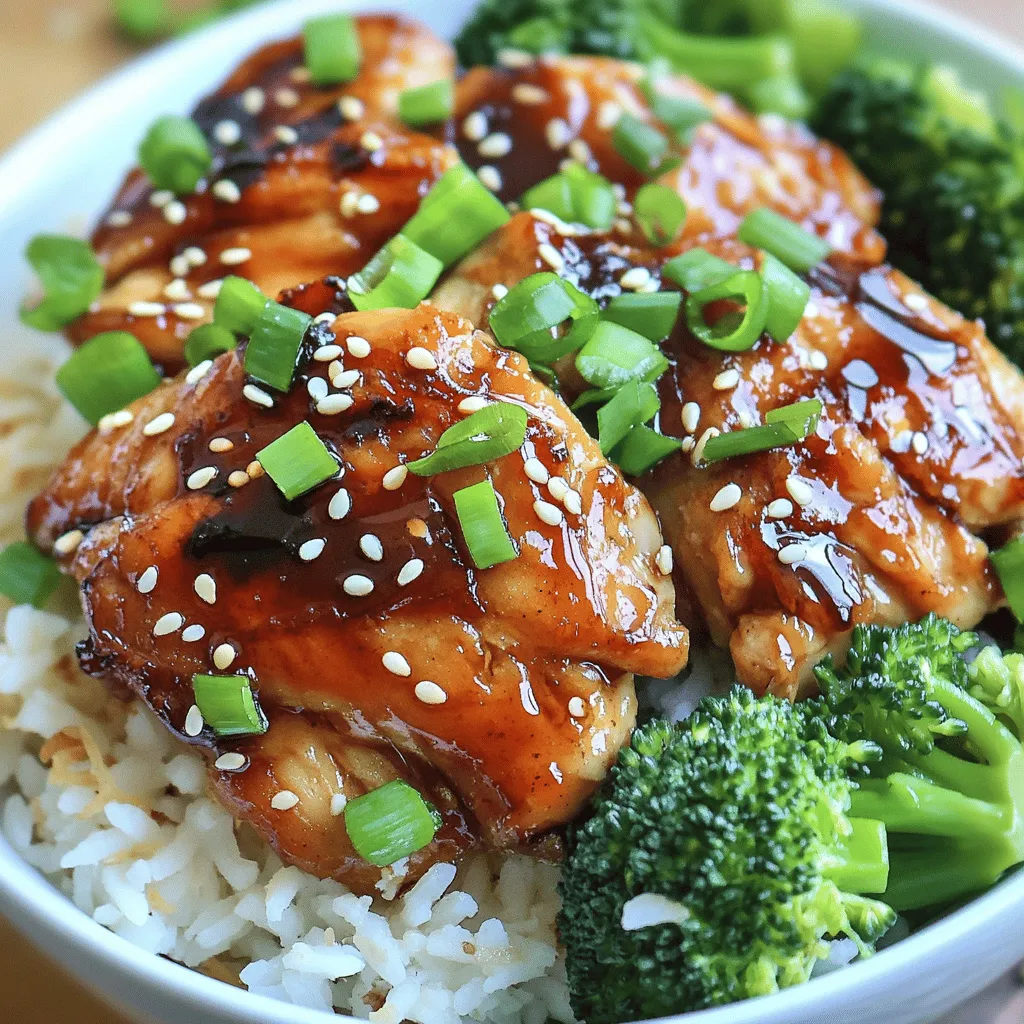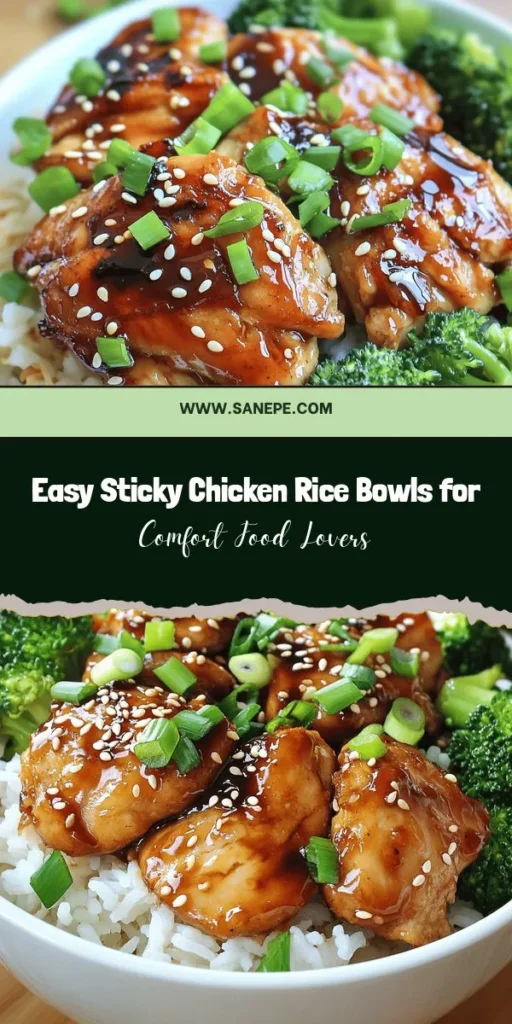When it comes to comfort food, few dishes can compete with the simplicity and satisfaction of a sticky chicken rice bowl. This delightful meal combines tender, marinated chicken with fluffy jasmine rice, creating a balance of flavors and textures that is both nourishing and indulgent. Sticky chicken rice bowls have surged in popularity, particularly among home cooks looking for quick and satisfying meals. With the growing trend of Asian-inspired cuisine, these bowls are perfect for busy weeknights or meal prepping, allowing you to enjoy a hearty dish without spending hours in the kitchen.
Understanding Sticky Chicken Rice Bowls
At the heart of sticky chicken rice bowls is a harmonious blend of sweet and savory flavors that makes each bite an experience. The chicken thighs soak in a tantalizing marinade that enhances their natural flavors while adding a delicious sticky glaze. The jasmine rice serves as a perfect base, known for its aromatic quality and fluffy texture that complements the richness of the chicken.
But what truly sets this dish apart is its versatility. You can customize your sticky chicken rice bowl to suit your tastes, whether that means adding a variety of fresh vegetables or adjusting the spice level to your liking. The appeal of a one-bowl meal lies in its convenience; it’s satisfying, wholesome, and can be enjoyed at any time of day.
Ingredients Overview
To create the ultimate sticky chicken rice bowl, you’ll need a selection of high-quality ingredients that come together to build flavor and texture. Let’s take a closer look at these essential components:
Jasmine Rice
Jasmine rice is a staple in many Asian households, celebrated for its delicate floral aroma and slightly sticky texture when cooked. This long-grain rice is perfect for absorbing the flavors of the marinade and the juices from the chicken, making each bite a delight. Rinsing the rice before cooking removes excess starch, ensuring that you achieve the perfect fluffy consistency.
Chicken Thighs
For this recipe, boneless, skinless chicken thighs are the star. They are preferred over chicken breasts for their tenderness and rich flavor. The higher fat content in thighs keeps the meat juicy during cooking, making them ideal for marinating. Plus, they tend to absorb flavors better, resulting in a more delicious final dish.
Marinade Components
The marinade is where the magic happens, blending various ingredients to create a sticky, flavorful coating for the chicken. Here are the key components:
– Soy Sauce: The backbone of the marinade, soy sauce provides a salty umami flavor that enhances the chicken’s natural taste.
– Honey: This ingredient adds sweetness and aids in creating that coveted sticky texture, balancing the saltiness of the soy sauce.
– Rice Vinegar: A splash of rice vinegar introduces a mild tang that cuts through the richness of the dish, adding depth to the overall flavor profile.
– Sesame Oil: Just a hint of sesame oil contributes a nutty aroma and flavor, elevating the dish and bringing out the best in the other ingredients.
– Garlic and Ginger: These aromatic staples are essential in Asian cooking, providing a warm, fragrant base that enhances the overall flavor of the marinade.
– Red Pepper Flakes: For those who enjoy a bit of heat, red pepper flakes can be added to the marinade, giving the dish a gentle kick.
Optional Ingredients
To elevate your sticky chicken rice bowl even further, consider adding fresh garnishes and vegetables. Chopped green onions and toasted sesame seeds not only enhance the visual appeal but also add layers of flavor and texture. Additionally, incorporating steamed vegetables like broccoli, snap peas, or bell peppers can boost the nutritional value and add vibrant colors to your bowl.
Preparation Steps
Now that you’re familiar with the ingredients, let’s dive into the preparation process. Each step is crucial for ensuring that your sticky chicken rice bowls turn out perfectly.
Preparing the Rice
Start by preparing your jasmine rice. Rinsing the rice is an essential step that should not be overlooked. Place the rice in a fine-mesh strainer and rinse it under cold running water until the water runs clear. This process helps remove excess surface starch, which can make the rice gummy during cooking.
Next, transfer the rinsed rice to a saucepan and add water. The typical ratio for jasmine rice is 1 cup of rice to 1.5 cups of water. Bring the water to a boil over medium-high heat, then reduce the heat to low, cover the pot, and let it simmer for about 15 minutes. Avoid lifting the lid during cooking, as this can release steam and interfere with the cooking process. Once the rice is cooked, remove it from the heat and let it sit, covered, for an additional 5 minutes. Fluff the rice gently with a fork before serving to ensure a light and airy texture.
Marinating the Chicken
While the rice is cooking, it’s time to marinate the chicken thighs. Begin by preparing the marinade in a mixing bowl. Whisk together the soy sauce, honey, rice vinegar, sesame oil, minced garlic, grated ginger, and red pepper flakes until well combined.
Place the chicken thighs in a large resealable plastic bag or a shallow dish, then pour the marinade over the chicken. Seal the bag or cover the dish, ensuring that the chicken is fully coated with the marinade. For optimal flavor, let the chicken marinate in the refrigerator for at least 30 minutes, but if you have the time, allowing it to marinate for 1-2 hours (or even overnight) will yield even better results.
When you’re ready to cook, remove the chicken from the marinade, letting any excess drip off. You can reserve the marinade for glazing during cooking or discard it, depending on your preference.
Cooking the Chicken
Now that the chicken has marinated and the rice is prepared, it’s time to cook the chicken. You can choose to grill, sauté, or bake the chicken thighs, depending on your cooking preferences and available equipment.
For grilling, preheat your grill to medium-high heat. Cook the chicken thighs for about 6-7 minutes on each side or until they reach an internal temperature of 165°F (75°C). For sautéing, heat a couple of tablespoons of oil in a large skillet over medium heat. Add the chicken thighs and cook for approximately 5-6 minutes per side, ensuring they are nicely browned and cooked through. If you choose to bake, preheat your oven to 400°F (200°C) and place the marinated chicken on a lined baking sheet. Bake for about 20-25 minutes, or until the chicken is cooked through and the edges are slightly caramelized.
Regardless of the cooking method you choose, allow the chicken to rest for a few minutes before slicing. This resting period is crucial as it allows the juices to redistribute, resulting in moist, tender chicken.
With these preparation steps complete, you are well on your way to creating delicious sticky chicken rice bowls that are not only visually appealing but also packed with flavor. The combination of tender chicken, fluffy jasmine rice, and vibrant garnishes makes for a satisfying meal that your family will love. Stay tuned for the next part, where we will explore how to assemble your bowls and serve them for maximum enjoyment.

Achieving the perfect sticky chicken rice bowls hinges not only on the quality of ingredients but also on the cooking method you choose. Here’s how to ensure your chicken thighs are perfectly cooked and packed with flavor.
Cooking Method
To start, heat a large skillet or a wok over medium-high heat. This will prepare your cooking surface for the chicken thighs, allowing for an excellent sear. Searing the chicken is crucial because it develops a rich, caramelized crust that adds depth to the overall flavor of the dish. Once the skillet is hot, add a tablespoon of oil, preferably sesame oil for that authentic Asian flavor.
Carefully place the marinated chicken thighs in the skillet, ensuring they are not overcrowded. Overcrowding can lead to steaming rather than searing, which is not what you want. Allow the chicken to cook undisturbed for about 5 to 7 minutes on one side. This is the time you want to achieve a beautiful golden brown crust.
To check for doneness, use an instant-read thermometer. The internal temperature should reach 165°F (75°C). If you don’t have a thermometer on hand, you can cut into one of the thicker thighs; the juices should run clear, and the meat should no longer be pink. Once the chicken is cooked through, remove it from the skillet and set it aside to rest. This resting period is vital as it allows the juices to redistribute throughout the meat, resulting in more tender and juicy chicken.
Making the Sauce
Next, it’s time to create a rich, glossy sauce that will tie the dish together. Using the same skillet, pour in the leftover marinade that the chicken was resting in. Bring it to a simmer over medium heat, allowing it to reduce for about 5 to 10 minutes. This process not only thickens the sauce but also intensifies the flavors. As the sauce reduces, keep an eye on it to prevent burning; you want it to become syrupy but not too thick.
Once reduced, taste the sauce and adjust the seasoning if necessary. If you prefer a touch of sweetness, consider adding a teaspoon of honey or brown sugar. This added sweetness can enhance the sticky texture and provide a delightful contrast to the savory elements of the dish. When the sauce reaches the desired consistency, remove it from the heat, and set it aside while you prepare to assemble your bowls.
Assembling the Bowls
Now, let’s assemble your sticky chicken rice bowls in a way that is visually appealing and full of flavor. Start with a generous scoop of cooked jasmine rice as your base. The fluffy rice perfectly complements the sticky chicken, soaking up all the delicious sauce.
Next, slice the rested chicken thighs into strips or bite-sized pieces and arrange them neatly on top of the rice. Drizzle the reduced marinade over the chicken, ensuring each piece is well-coated.
For a balanced and colorful presentation, add a variety of vegetables around the chicken. Options include steamed broccoli, shredded carrots, and snap peas, all of which contribute both crunch and nutrition. You can also include fresh herbs like cilantro or green onions for a pop of freshness, or sesame seeds for texture.
Don’t hesitate to customize your bowls based on your preferences or what you have on hand. The beauty of this dish is its versatility. You can add grilled bell peppers for sweetness, or even pickled veggies for an added tang.
Nutritional Benefits of Sticky Chicken Rice Bowls
Sticky chicken rice bowls are not only delicious but also nutritionally balanced. Here’s a breakdown of the key ingredients and their benefits:
– Protein from Chicken Thighs: Chicken thighs are a great source of protein, essential for muscle repair and growth. They also provide important vitamins and minerals, such as B vitamins and iron.
– Carbohydrates from Jasmine Rice: Jasmine rice is a fragrant, long-grain rice that serves as an excellent source of carbohydrates, providing the energy needed for daily activities. It is also gluten-free, making it suitable for those with gluten intolerances.
– Vitamins and Minerals from Optional Vegetables: Adding a variety of vegetables not only enhances the flavor and texture but also boosts the nutritional profile. Vegetables like broccoli and carrots provide dietary fiber, vitamins A and C, and antioxidants.
– Healthy Fats from Sesame Oil: The sesame oil used for cooking adds heart-healthy fats to the dish, which can help reduce inflammation and promote overall health.
Variations and Adaptations
This recipe is highly adaptable, allowing you to cater to different dietary preferences and available ingredients.
– Vegetarian or Vegan Alternatives: For those looking for plant-based options, consider using tofu or tempeh in place of chicken. Marinate and cook them the same way to absorb all those delicious flavors.
– Different Marinade Flavors: While the original marinade is delightful, feel free to experiment with different flavors. A teriyaki sauce, spicy chili garlic sauce, or a citrus-based marinade can give your bowls a unique twist.
– Additional Ingredients: Consider incorporating other vegetables like bell peppers, snap peas, or even corn for added sweetness. You can also serve the bowls with a side of kimchi or pickled ginger for a burst of flavor.
Conclusion
Sticky chicken rice bowls are an incredibly versatile meal option that offers a delightful balance of flavors, textures, and nutritional benefits. With their tender chicken, aromatic rice, and vibrant vegetables, they are perfect for both family dinners and quick weeknight meals. The ease of preparation means you can have a delicious homemade meal on the table in no time.
Encourage your family or friends to join you in the kitchen to make this dish together, creating a fun and engaging cooking experience. Whether you are enjoying these bowls solo or sharing them with loved ones, they are sure to become a favorite in your home-cooked repertoire. So gather your ingredients, follow these steps, and savor the deliciousness of sticky chicken rice bowls that are not only satisfying but also a testament to the joy of cooking at home.


